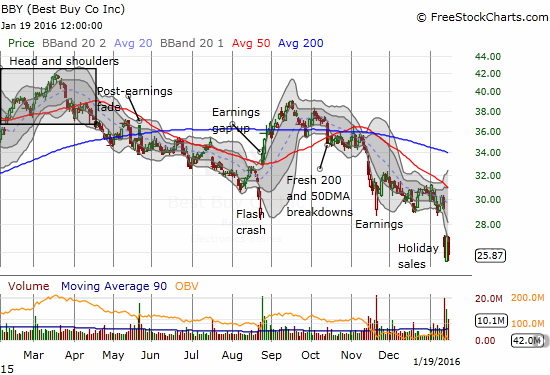Ever since I recommended shorting the SPDR S&P Retail ETF (XRT), I have been keen to look for opportunities to short individual retail names. A huge exception was Wal-Mart (WMT) which is currently making an encouraging bottoming move after a long 2015 of nearly non-stop selling. I noted Best Buy (BBY) as a prime target ahead of its November earnings. Given the selling ahead of that report, I decided to wait to pull the trigger.
After reporting earnings, BBY gapped down 6.8%. Buyers stepped right in from there and at one point were able to put BBY into the green. I bought put options to fade the fade. A month later the stock had effectively gone nowhere, so I rolled over the expiration one more month. It just so happened that BBY reported holiday sales directly ahead of the January expiration. I closed out the position as the stock fell as much as 12.5%. This time, buyers were only able to reverse a small fraction of the losses.

Best Buy (BBY) has hit prices last seen May, 2014. Can the remaining money in the buyback keep the stock from bleeding even more?
Source: FreeStockCharts.com
While the holiday sales report contained warnings, it also contained some assurances and an important catalyst that could make BBY a good bet off the bottom going into earnings roughly in late February/early March.
First the warnings…
Domestic revenue declined 0.8% led by greater than expected revenue declines in mobile phones and NPD-related categories (a revenue drop of 4.8%). The NPD Group includes TVs, desktop and notebook computers, tablets not including Kindle, digital imaging and other categories. BBY indicated sales of NPD productss are about 65% of Domestic revenue. As a result of the unexpected declines, BBY reduced guidance for domestic Q4 revenue growth from flat to a decline of 1.5%.
Next, the assurances…
BBY also improved Q4 guidance for a non-GAAP operating income rate decline of 20 to 35 basis points to 10 to 15 basis points. Guidance for the international business remains unchanged. Canada is a large driver of an expected 30% decline in revenue (partially thanks to the sharp decline in the Canadian dollar).











Leave A Comment